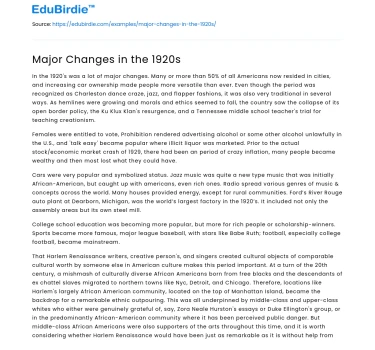In the 1920's was a lot of major changes. Many or more than 50% of all Americans now resided in cities, and increasing car ownership made people more versatile than ever. Even though the period was recognized as Charleston dance craze, jazz, and flapper fashions, it was also very traditional in several ways. As hemlines were growing and morals and ethics seemed to fall, the country saw the collapse of its open border policy, the Ku Klux Klan's resurgence, and a Tennessee middle school teacher's trial for teaching creationism.
Females were entitled to vote, Prohibition rendered advertising alcohol or some other alcohol unlawfully in the U.S., and 'talk easy' became popular where illicit liquor was marketed. Prior to the actual stock/economic market crash of 1929, there had been an period of crazy inflation, many people became wealthy and then most lost what they could have.
Save your time!
We can take care of your essay
- Proper editing and formatting
- Free revision, title page, and bibliography
- Flexible prices and money-back guarantee
Cars were very popular and symbolized status. Jazz music was quite a new type music that was initially African-American, but caught up with americans, even rich ones. Radio spread various genres of music & concepts across the world. Many houses provided energy, except for rural communities. Ford’s River Rouge auto plant at Dearborn, Michigan, was the world’s largest factory in the 1920’s. It included not only the assembly areas but its own steel mill.
College school education was becoming more popular, but more for rich people or scholarship-winners. Sports became more famous, major league baseball, with stars like Babe Ruth; football, especially college football, became mainstream.
That Harlem Renaissance writers, creative person's, and singers created cultural objects of comparable cultural worth by someone else in American culture makes this period important. At a turn of the 20th century, a mishmash of culturally diverse African Americans born from free blacks and the descendants of ex chattel slaves migrated to northern towns like Nyc, Detroit, and Chicago. Therefore, locations like Harlem's largely African American community, located on the top of Manhattan Island, became the backdrop for a remarkable ethnic outpouring. This was all underpinned by middle-class and upper-class whites who either were genuinely grateful of, say, Zora Neale Hurston's essays or Duke Ellington's group, or in the predominantly African-American community where it has been perceived public danger. But middle-class African Americans were also supporters of the arts throughout this time, and it is worth considering whether Harlem Renaissance would have been just as remarkable as it is without help from within that African American enclave.






 Stuck on your essay?
Stuck on your essay?

